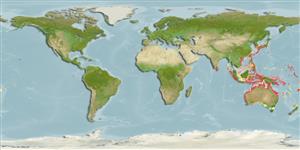Preferred temperature (Ref.
123201): 18.6 - 29.3, mean 28.4 °C (based on 2050 cells).
Phylogenetic diversity index (Ref.
82804): PD
50 = 0.5039 [Uniqueness, from 0.5 = low to 2.0 = high].
Bayesian length-weight: a=0.00794 (0.00359 - 0.01758), b=2.80 (2.61 - 2.99), in cm total length, based on LWR estimates for this (Sub)family-body shape (Ref.
93245).
ระดับชั้นอาหาร (Ref.
69278): 3.7 ±0.4 se; based on size and trophs of closest relatives
ความสามารถในการกลับคืนสู่ปกติ (Ref.
120179): ความสูง, เวลาต่ำสุดที่จะทำให้ประชากรเพิ่มขึ้นเป็น 2 เท่าใช้เวลาน้อยกว่า 15 เดือน (Preliminary K or Fecundity.).
Fishing Vulnerability (Ref.
59153): Low vulnerability (10 of 100).
Nutrients (Ref.
124155): Calcium = 109 [43, 220] mg/100g; Iron = 0.865 [0.454, 1.627] mg/100g; Protein = 19 [18, 20] %; Omega3 = 0.155 [0.077, 0.299] g/100g; Selenium = 11.2 [4.5, 26.6] μg/100g; VitaminA = 84 [23, 313] μg/100g; Zinc = 1.51 [0.87, 2.41] mg/100g (wet weight);
